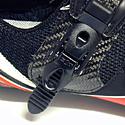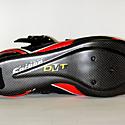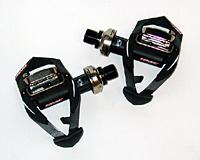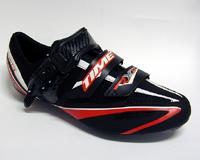
Recently on Cyclingnews.com |
On test: Time RXS Carbon pedals and shoes, October 22, 2005
Time in, Time out
When the time comes for a change, sometimes it's better to do things one at a time, or at least hang on to ol' faithful, as Anthony Tan discovers with Time's RXS Carbon pedals and shoes.
|
|
Changing bike pedals is a decision not to be taken lightly. It's up there with changing shoes, saddles - even frames.
So when Tech chief John Stevenson handed me a new set of pedals and shoes to test, I was a little hesitant. That both were made by Time, a brand I had used a number of years previously and with good result, mitigated my initial nervousness to a degree.
Admittedly, I was very keen to get my paws on both items. In the early 90s, I, like many, jumped on the bandwagon when the likes of LeMond and Indurain were seen using the French firm's pedals and shoes. And the offer of free rotational movement or 'float' within the pedal axle rather than the cleat was a novel design that worked brilliantly. Having the sole of your shoe as close as possible to the pedal axle was another advantage, and needless to say, both proved to be strong selling points.
Time's RXS Carbon pedals represent a lightened version of the Impact pedals that were introduced in 2003, which in turn were a lightened version of earlier Equipe models that had essentially remained unchanged since their introduction back in the late 1980s. Yes, I am starting to show my age now, aren't I...

|
Still offering roughly the same float either side (±5 degrees, with 2.5mm of lateral float) and a low stack height (now 8mm), the new, triangular-shaped design is actually more similar in look to the Equipe pedal of old, rather than its Impact predecessor. Maybe that's got something to do with the original design being significantly more popular among the serious road bike community, which in part explains their longevity in what was becoming an increasingly crowded market.
Where this newbie differs, however, is in the weight stakes: the futuristic carbon body brings the gram-count down to 260 per pair. Add on 120 grams' worth of cleats and mounting hardware and you've got yourself a very lightweight set of flippers; not quite as light as the equivalent Speedplay Zeros with the steel axle (around 200 grams/pair), but no fat slob nonetheless. The pedals also offer the ability to adjust Q-factor by 2.5mm, accomplished by swapping the side-specific cleats over.
Onto the shoes. At 600 grams per pair for a size 42.5, the RXS Carbon shoes are equally weight-competitive, comparing favourably with Shimano's SH-R215 carbon shoes (around 10 grams heavier for a size 42). While the synthetic last and upper are made by Time, the sole and ratchet buckle are both from DMT, the former going down today's path of offering just the three-hole fit to accommodate Look-style cleat arrangements, including the Time's RXS Café cleat. As the name implies, the Café cleats were designed with cappuccino stops in mind, incorporating three non-slip, hardened rubber stabilisers to prevent any wipe-outs at your favourite place du park-up.
So with pedals screwed on, cleats screwed in and shoes fastened, I was off!

|
As mentioned earlier, switching from an all-Shimano set-up (my previous shoe/pedal combination being Shimano's SPD-SL pedals and SH-R215 shoes) was a bold move, so I was expecting some discomfort to begin with. The pedals weren't so much the problem - in fact, I still remember the assured, gloriously firm 'snap' made as cleat engaged with pedal for the very first time and the liberal feeling of free float as only Time knows how - it was more the shoes that felt a much narrower than my Shimanos, evidenced by my feet coming back sore and slightly raw after each ride.
For the time being, though, I put the tightness down to the breaking in period invariably associated with any shoe. However, the flat-as-a-tack DMT carbon sole was certainly a change from the Shimano's rather 'archy' (yes, I know that's not a word) equivalent, not to mention Time's own shoes pre-DMT.
There's two schools of thought as to what's best for a rider: the flat sole theorists claiming better power transfer and the Archies (TM) claiming better support in line with the curvature of the foot, especially for those with a tendency to pronate (roll one's foot inwards). Unusually, I have quite flat feet but welcome an arched sole, but that can be in part explained by my tendency to roll inwards when walking and the use of orthotics in my running/hiking shoes to compensate for this.

|
Still, I was willing to give both shoes and pedals a good go. Or was that more due to being stationed Switzerland and my old cycling shoes were 18,000 kilometres away in Sydney? Whatever the case, I tried and tried and tried (equivalent to three months' of trying!), until the moment came when my feet squealed, 'Enuff, already!' - which led to a subsequent phone call to my old man: "Dad, go look for a silvery-looking pair of cycling shoes in my apartment, put them in a box, and post 'em to Suisse, pronto!"
Unlike the shoes, the RXS pedals were a godsend from bike heaven. Really, these guys have got it down pat with the 'float thang' and while they may not cure your dodgy knee/s, they will undoubtedly relieve pressure on your joints compared to a fixed cleat/zero float arrangement. Adjusting tension of the retention mechanism is easy, simply done with a Allen key; however, increasing the tension simultaneously reduces your sensation of float, so I let it be. Importantly, the three chunky stabilizers not only stop you from going A over T at your local café, they also protect the recessed brass cleat from wear.
So, all in all, a mixed bag of goodies from Time. My take on this is that both are a very personal choice, and particularly with shoes, you either like them or you don't - I didn't. An important consideration with shoes is to try on a pair for as long as you can before buying them, doing them up and undoing them until the salesperson falls asleep, and get plenty of second opinions. If you're considering the RXS Carbons, remember that the DMT sole makes for a narrower fit compared to Time's predecessors, which were more similar to the Carnacs, Shimanos and Specializeds of today.
Wear & tear
Just a quick note on longevity. The RXS Carbon shoes I didn't wear long enough for anything to fall apart, although I did have to tighten the ratchet buckle once or twice after it came loose - this can easily be fixed with an Allen key. Thanks to the three chunky stabilisers that stop the brass cleat from making contact with the ground when walking, snapping the Café cleats into the pedal was just as easy after six months as it was during the first month. As for the RXS pedals, no real problems apart from a tiny clicking noise on the right-side pedal. It's certainly not affecting my pedalling and the sound's so tiny it's almost not worth mentioning; I've tried re-greasing and re-oiling but to no avail - so long as I don't hear it when I'm riding, I'm fine with it.
Photography
For a thumbnail gallery of these images, click here
Images by John Stevenson/Cyclingnews.com
- Time's RXS Carbon pedals are far more similar in design to the original Equipe pedal used by Greg LeMond and Miguel Indurain in the late 80s and early 90s than its Impact predecessor.
- The RXS pedals consist of a composite reinforced body with carbon fibre and a steel axle.
- The RXS Café cleats were designed with cappuccino stops in mind. The three non-slip, hardened rubber stabilisers also protect the brass cleat from wear.
- Time's RXS Carbon shoe.
- An Italian import - the ratchet buckle, made by DMT.
- The made in Italy DMT carbon sole is quite a change from the French company's previous models.
- The three-hole, Look-style cleat design has become the virtual standard with today's cycling footwear.
- Half-breed - French-Italo design makes this model suitable for someone looking for something in between, say, a Carnac and DMT shoe.
Time RXS Carbon pedals
Retail price: US$179.95; RXS Café cleat US$39.95
Weight: 259 grams per pair
Materials: Composite reinforced body with carbon fiber, steel axle.
Pros: Free float mechanism in pedal mechanism rather than cleat, light
weight, good size pedalling platform (ratio of platform surface to weight: 23
mm˛ per gram), minimal distance from sole to pedal axle for improved efficiency,
Café cleat well designed.
Cons: Well, there's a Carbon/Ti version, which uses a titanium axle,
bringing the weight down to 195 grams/pair (you got the money, they got the
pedal); replacement cleats ain't cheap.
More information: Time
USA's website
Cyclingnews Rating: ![]()
Time RXS Carbon shoes
Retail price: US$229.95
Weight: 600 grams per pair
Materials: Synthetic upper with lateral vents, padded inner tongue, thermoformed
removable insole, DMT carbon sole & ratchet buckle
Pros: Light weight, heel and tongue well padded
Cons: Forefoot too narrow, flat sole didn't suit, synthetic upper not
as comfortable as leather and do not 'break in'
More information: Time
USA's website
Cyclingnews Rating: ![]()



